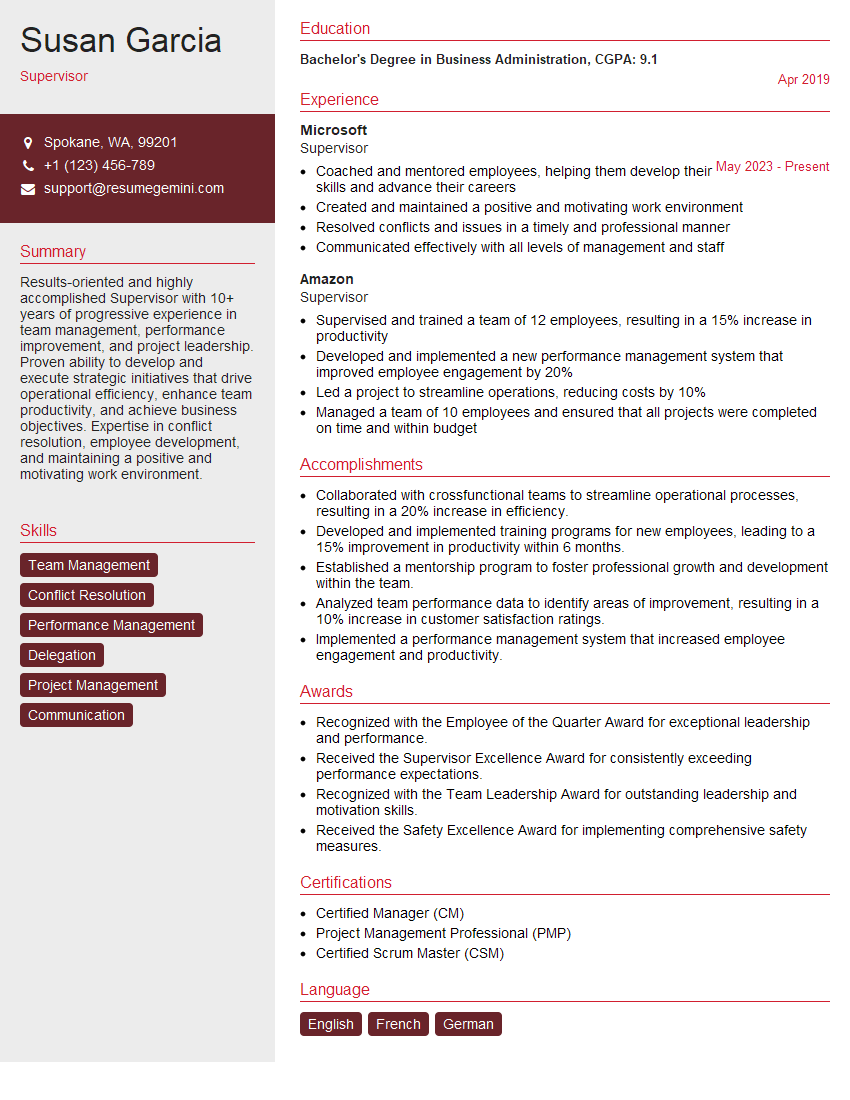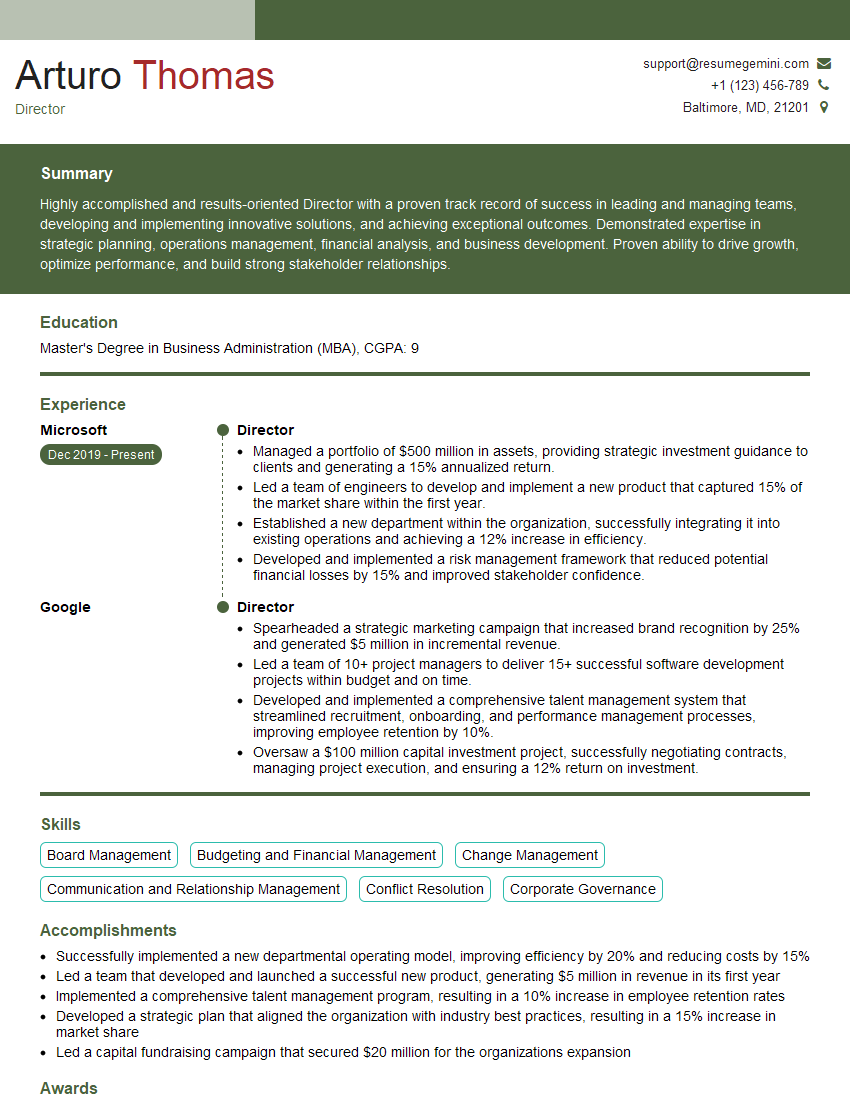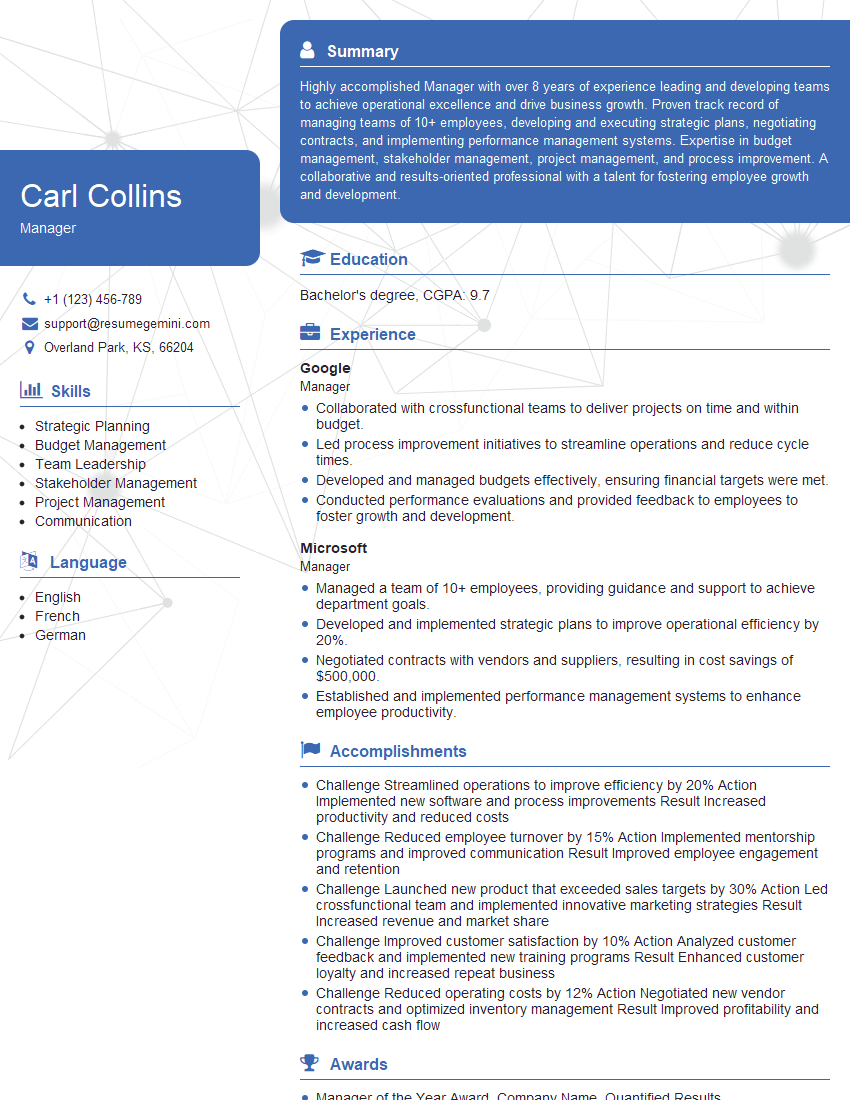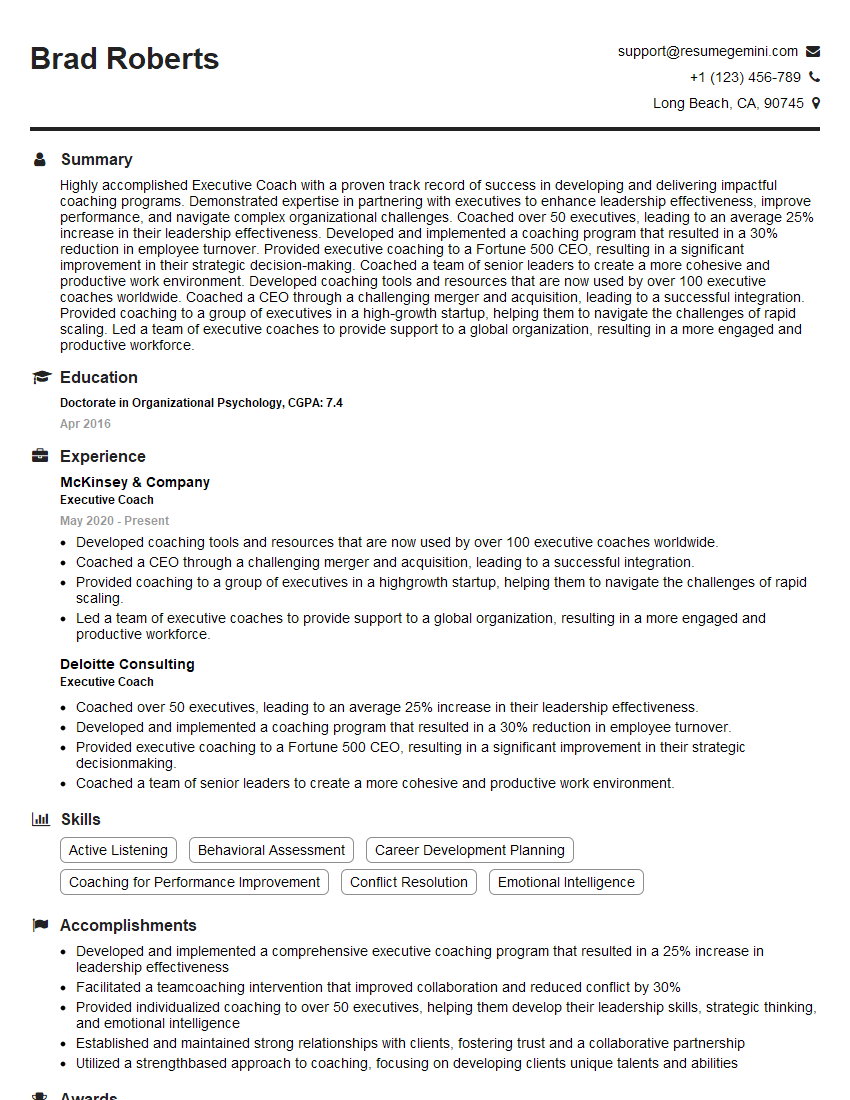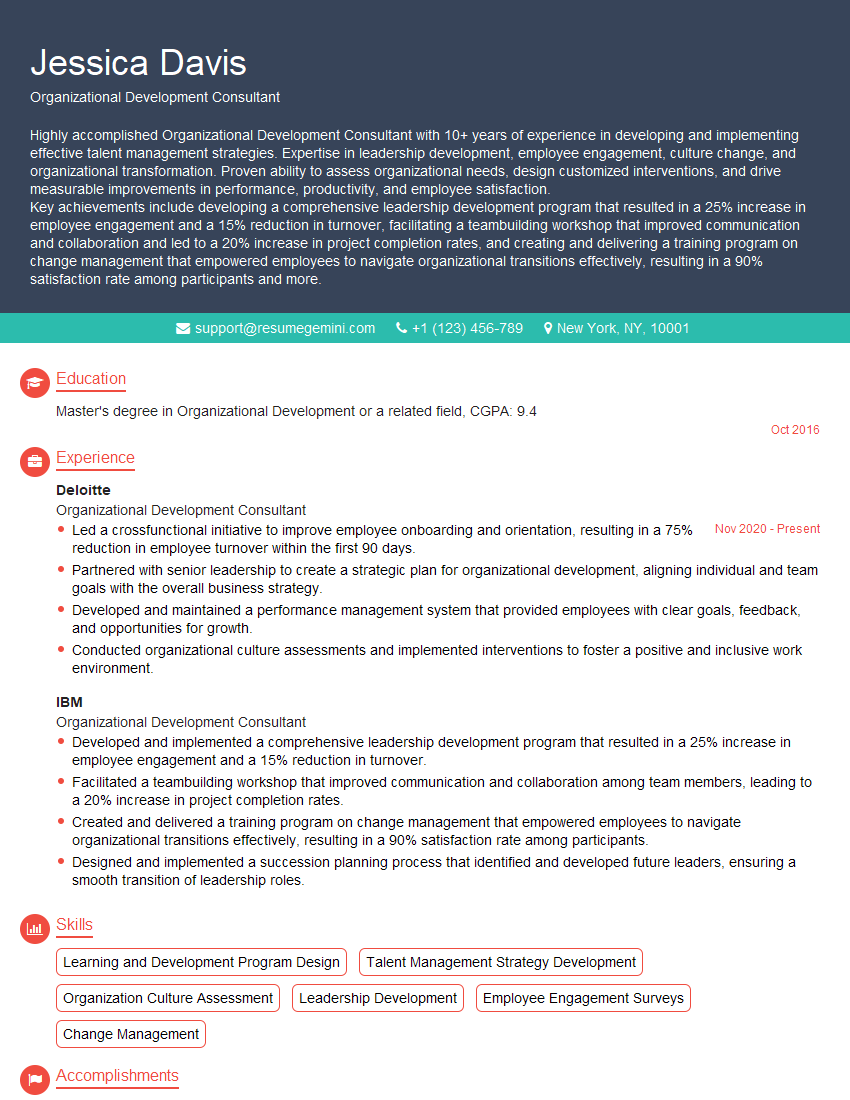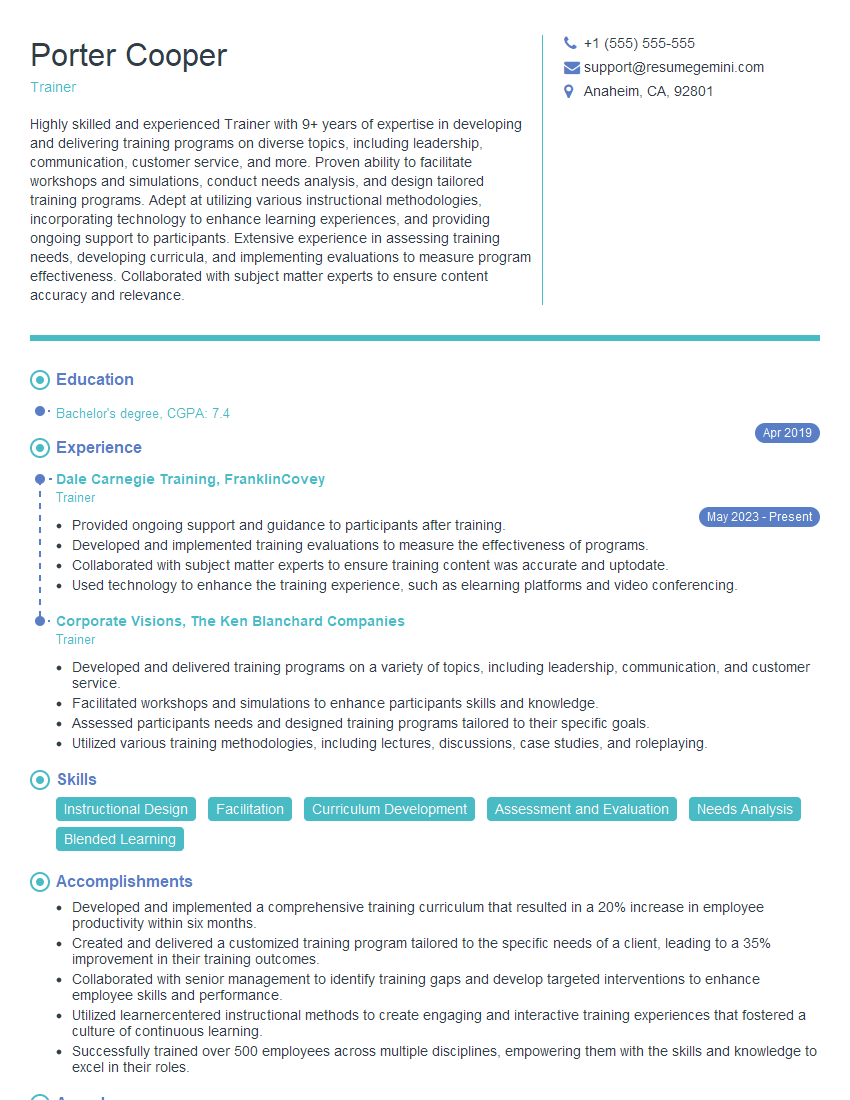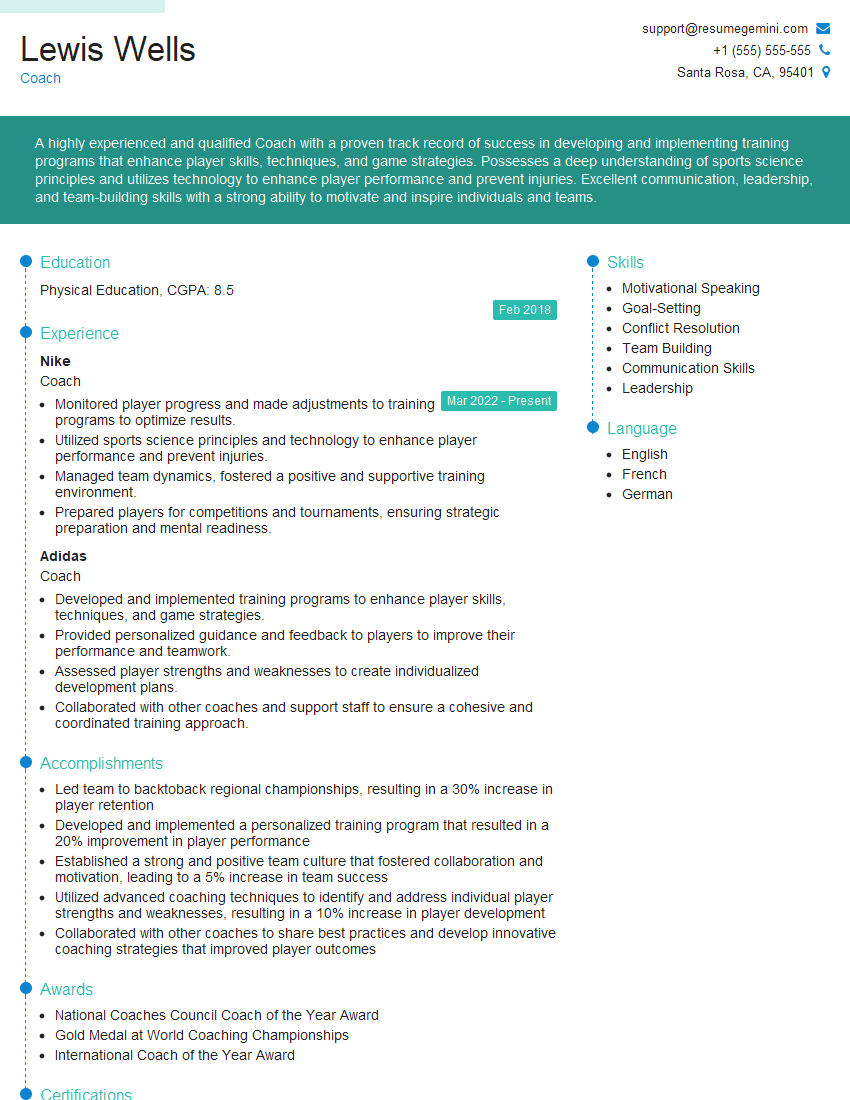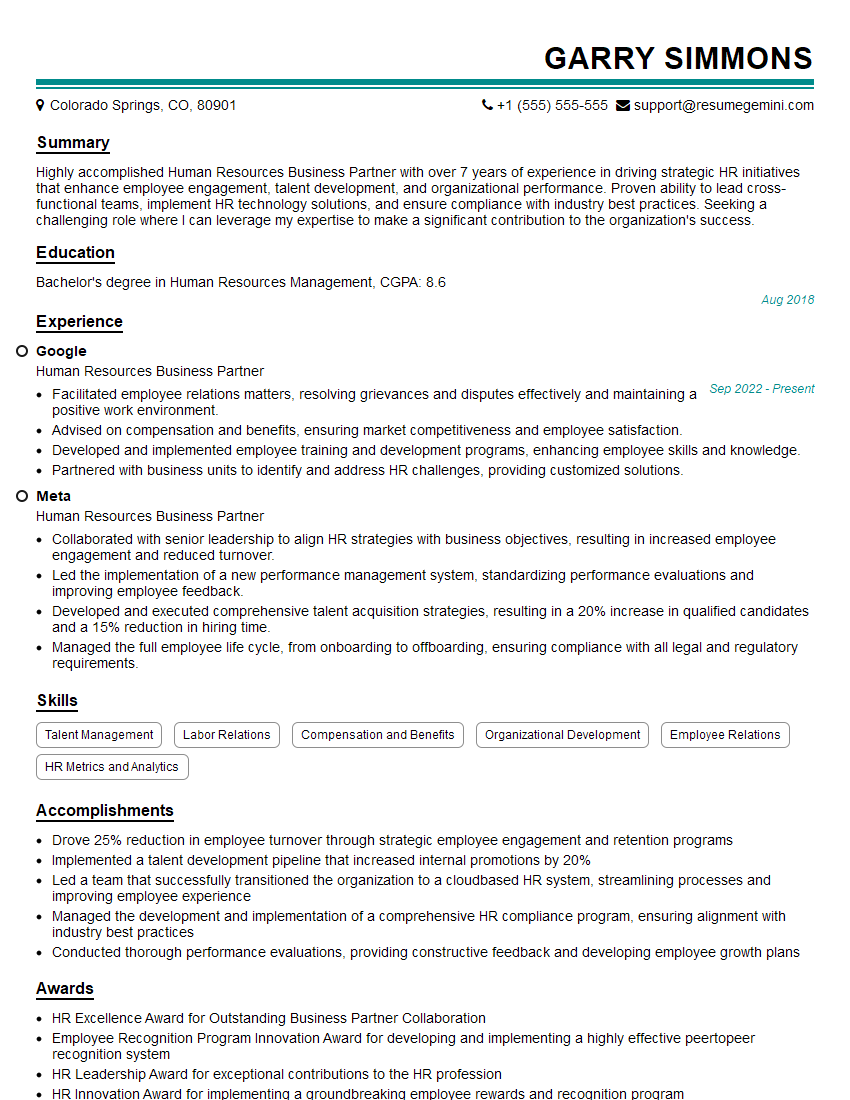Feeling uncertain about what to expect in your upcoming interview? We’ve got you covered! This blog highlights the most important Providing constructive feedback interview questions and provides actionable advice to help you stand out as the ideal candidate. Let’s pave the way for your success.
Questions Asked in Providing constructive feedback Interview
Q 1. Describe your approach to delivering constructive feedback in a team setting.
My approach to delivering constructive feedback in a team setting prioritizes a collaborative and respectful environment. I believe feedback is most effective when it’s a two-way street, fostering growth and shared understanding. I typically begin by setting a positive and open tone, emphasizing that the feedback is intended to help improve performance and achieve shared goals. I then follow a structured approach:
- Preparation: Before the feedback session, I carefully consider the specific behaviors or outcomes I want to address. I gather concrete examples to support my observations, ensuring the feedback is objective and specific rather than subjective or emotional.
- Private Setting: I prefer to deliver feedback in a private setting to ensure the individual feels comfortable and respected. This allows for an open and honest conversation without the pressure of a public audience.
- Positive Framing: I always begin by acknowledging the individual’s strengths and positive contributions before addressing areas for improvement. This helps create a positive context and demonstrates that the feedback is focused on growth, not criticism.
- Specific and Actionable Feedback: The feedback itself is framed using the SBI (Situation-Behavior-Impact) model. I describe the situation, the specific behavior observed, and the impact of that behavior. This helps ensure clarity and understanding.
- Collaborative Discussion: I encourage a two-way dialogue, allowing the individual to share their perspective and ask clarifying questions. This helps build understanding and ownership.
- Agreed-Upon Actions: I work collaboratively to identify specific, measurable, achievable, relevant, and time-bound (SMART) goals and actions for improvement. This ensures the feedback translates into tangible progress.
- Follow-up: I schedule a follow-up meeting to discuss progress and provide further support if needed. This reinforces commitment and shows that I am invested in the individual’s success.
This structured approach ensures that the feedback is received constructively and contributes positively to team dynamics and individual growth.
Q 2. How do you tailor your feedback to the individual’s personality and communication style?
Tailoring feedback to individual personality and communication styles is crucial for its effectiveness. Understanding different communication preferences – whether someone is direct, indirect, detail-oriented, or big-picture focused – significantly impacts how the feedback is received and acted upon.
- Direct vs. Indirect Communicators: For direct communicators, I provide clear, concise feedback, directly addressing the issue. For indirect communicators, I use a more nuanced and empathetic approach, focusing on the impact of their actions rather than direct criticism.
- Detail-Oriented vs. Big-Picture Focused: For detail-oriented individuals, I provide comprehensive feedback with specific examples. For those who are big-picture focused, I summarize key areas for improvement and connect them to broader goals.
- Visual, Auditory, Kinesthetic Learners: I adjust my delivery method according to learning styles. Visual learners benefit from charts or diagrams; auditory learners respond well to verbal explanations; kinesthetic learners may benefit from role-playing or hands-on exercises.
- Personality Traits: I adapt my tone and language according to personality. For example, I might use more encouragement with someone who is self-conscious, or a more direct approach with someone who is assertive.
By understanding individual preferences and adapting my approach, I ensure that the feedback is not only understood but also positively received and effectively applied.
Q 3. Explain a situation where you had to deliver difficult feedback. What was your approach, and what was the outcome?
I once had to deliver difficult feedback to a team member whose performance had consistently fallen short of expectations despite previous informal coaching. The situation involved missed deadlines and a lack of attention to detail on several critical projects. My approach was crucial in this situation.
- Careful Documentation: I meticulously documented all instances of underperformance, including specific examples and dates. This ensured the feedback was objective and backed by evidence.
- Empathetic and Respectful Tone: I began the conversation by acknowledging the team member’s contributions in other areas. I emphasized that my goal was to help them improve and succeed.
- Focus on Behavior, Not Personality: I focused on the specific behaviors that were impacting their performance, avoiding personal attacks or judgment. For instance, instead of saying ‘you’re lazy,’ I said ‘the missed deadlines on projects X and Y impacted the team’s ability to meet its overall objectives.’
- Collaborative Problem-Solving: I presented the feedback as a problem to be solved collaboratively, involving the team member in identifying potential solutions and setting realistic improvement goals.
- Agreed-Upon Action Plan: We created a clear action plan with specific, measurable, achievable, relevant, and time-bound goals. This included regular check-ins to monitor progress.
The outcome was positive. The team member, initially defensive, eventually acknowledged their shortcomings and committed to improvement. Through consistent support and follow-up, their performance significantly improved. The key was to approach the situation with empathy and a focus on collaboration and problem-solving, rather than blame or punishment.
Q 4. How do you ensure that your feedback is specific, actionable, and measurable?
Ensuring feedback is specific, actionable, and measurable is vital for its effectiveness. Vague feedback often leaves individuals confused and unable to make necessary changes. I use the following techniques:
- Use the SBI Model (Situation-Behavior-Impact): This framework provides structure for clear and concise feedback. For example: Situation: During the last team meeting, Behavior: you interrupted several team members, Impact: this disrupted the flow of discussion and prevented others from fully contributing their ideas.
- Focus on Observable Behaviors: Instead of making assumptions about intentions or personality, concentrate on what was actually observed. Avoid subjective terms and generalizations.
- Quantify Whenever Possible: If possible, use numbers or data to support your feedback. For example: ‘Your report contained five factual errors.’
- Suggest Specific Actions: Instead of simply stating a problem, suggest concrete steps for improvement. For example: ‘To improve your report writing, I suggest reviewing the style guide and using a checklist to ensure accuracy before submission.’
- Set SMART Goals: Collaboratively set goals that are Specific, Measurable, Achievable, Relevant, and Time-bound (SMART). This ensures progress can be tracked and success defined.
By applying these techniques, I ensure that my feedback is not only clear but also actionable and easily understood, allowing the recipient to make meaningful improvements.
Q 5. What techniques do you use to create a safe space for receiving and giving feedback?
Creating a safe space for feedback requires building trust and fostering a culture of psychological safety where individuals feel comfortable expressing themselves without fear of judgment or retribution. I utilize several techniques:
- Establish Ground Rules: Before the feedback session, establish clear ground rules for respectful communication, active listening, and constructive dialogue. This ensures everyone understands the expectations for the interaction.
- Emphasize Confidentiality: Reassure individuals that their feedback will be kept confidential. This fosters trust and encourages open and honest communication.
- Focus on Learning and Growth: Frame the feedback session as an opportunity for learning and growth, rather than a performance evaluation. Emphasize that the goal is to improve, not to criticize.
- Active Listening and Empathy: Actively listen to the individual’s perspective and demonstrate empathy. This shows that you value their input and understand their feelings.
- Non-Judgmental Language: Use non-judgmental language, avoiding words that might be perceived as accusatory or critical. Focus on describing behaviors and their impact, not on making value judgments about the person.
- Positive Reinforcement: Begin and end the feedback session by acknowledging the individual’s strengths and contributions. This creates a more balanced and positive context for the feedback.
By cultivating a safe space through these techniques, I encourage open communication and create an environment conducive to both giving and receiving constructive feedback.
Q 6. How do you handle situations where feedback is not well-received?
When feedback is not well-received, it’s crucial to understand the reasons behind the negative reaction. It’s rarely about the feedback itself, but more often about the way it’s delivered or the recipient’s emotional state. My approach involves:
- Active Listening and Empathy: I listen carefully to the individual’s concerns and try to understand their perspective. This often involves asking clarifying questions to ensure I fully understand their reaction.
- Validate their Feelings: I acknowledge and validate their feelings, even if I don’t agree with their perspective. This helps to de-escalate the situation and create space for a more productive conversation.
- Reframe the Feedback: I might reframe the feedback using different words or examples, ensuring it’s understood clearly and accurately.
- Focus on the Behavior, Not the Person: I reinforce that the feedback focuses on specific behaviors and their impact, not on personal characteristics or judgments.
- Seek Clarification: I ask open-ended questions to understand why the feedback wasn’t well-received and how I can improve my communication style.
- Schedule a Follow-up: If the initial conversation is unproductive, I suggest a follow-up meeting to further discuss the feedback and address any remaining concerns.
The goal is to create a dialogue that fosters understanding and leads to positive change, even if the initial reaction is negative. The key is patience, empathy, and a willingness to adapt my approach based on the individual’s response.
Q 7. How do you balance positive reinforcement with constructive criticism?
Balancing positive reinforcement with constructive criticism is essential for effective feedback. A solely critical approach can be demoralizing, while a solely positive approach fails to address areas for improvement. My approach involves a sandwich method that emphasizes both positive and negative feedback:
- Start with Positive Reinforcement: I begin by acknowledging the individual’s strengths and positive contributions. This sets a positive tone and creates a receptive environment.
- Deliver Constructive Criticism: I then address areas for improvement, using the SBI model and focusing on specific behaviors and their impact.
- End with Positive Reinforcement and Future Focus: I conclude by reiterating the individual’s strengths and expressing confidence in their ability to improve. I also focus on future opportunities for growth and development.
- Maintain a Consistent Ratio: While the ratio of positive to negative feedback may vary depending on the situation, I strive for a balance that reinforces both strengths and areas needing improvement.
This approach helps ensure that the feedback is received positively, motivating individuals to make necessary changes while maintaining morale and confidence. The goal is not to simply highlight negatives but to create a balanced perspective that encourages growth and development.
Q 8. How do you identify the root cause of a performance issue before providing feedback?
Identifying the root cause of a performance issue is crucial before offering feedback. It’s like diagnosing a car problem – you wouldn’t just replace parts randomly; you’d pinpoint the malfunction first. My approach involves a systematic investigation. I start by gathering information through observation, data analysis (if available), and direct conversations with the individual. I ask clarifying questions to understand the context and any contributing factors. For example, if someone consistently misses deadlines, I’d explore if it’s due to unrealistic project timelines, lack of resources, insufficient training, or personal circumstances. Once I’ve collected sufficient data, I use a structured approach like the ‘5 Whys’ technique – repeatedly asking ‘why’ to drill down to the core issue. This iterative process helps uncover the underlying cause, allowing me to tailor my feedback effectively.
Example: Let’s say a sales representative consistently underperforms. Instead of simply saying ‘You’re not meeting your targets,’ I’d investigate. Why aren’t they meeting targets? Is it because they lack effective lead generation skills? Why? Is it because they haven’t received adequate training on lead qualification? Why? Is it due to a lack of available training resources? This iterative questioning helps isolate the real problem, which might be a systemic issue rather than individual shortcomings.
Q 9. What are some common pitfalls to avoid when giving constructive feedback?
Giving constructive feedback is a delicate art, and several pitfalls can sabotage its effectiveness. One major pitfall is delivering feedback emotionally or judgmentally. Instead of focusing on behaviors and their impact, criticism can become personal attacks. For example, saying ‘You’re lazy’ is unproductive; saying ‘The deadline was missed, impacting project X’ is far more constructive.
- Avoid generalizations: Instead of saying ‘You always…’, focus on specific instances.
- Refrain from offering unsolicited advice unless explicitly asked for. It’s better to ask open-ended questions like ‘How do you think we can improve this?’
- Don’t overload with feedback. Prioritize the most important areas for improvement. Too much feedback can be overwhelming and dilute the message.
- Avoid sandwhiching – placing positive feedback before and after criticism. While seemingly kind, it can diminish the impact of the critical feedback.
- Don’t focus solely on the negative. Always balance criticism with recognition of strengths and accomplishments.
Imagine giving feedback on a presentation. Instead of saying ‘That was a terrible presentation,’ a better approach would be, ‘The data visualization could be improved for better clarity, but your introduction was engaging and the conclusion was powerful.’ This highlights both strengths and areas for improvement, encouraging positive change.
Q 10. How do you follow up after delivering constructive feedback?
Following up after delivering constructive feedback is vital for ensuring its effectiveness. It demonstrates your commitment to the individual’s growth and provides an opportunity to reinforce the message and check for progress. My typical follow-up involves a brief check-in a few days later, not to assess performance, but to inquire if they had the opportunity to reflect on the feedback and if they have any questions. I also ask whether they need any additional resources or support to implement the suggestions. I may schedule a more formal follow-up meeting after a reasonable time period (e.g., two weeks) to discuss progress and address any challenges. This ongoing support makes the individual feel heard and encouraged, enhancing the overall effectiveness of the feedback.
Example: After giving feedback on a report, I might say, ‘How are you finding the time to implement the suggestions I mentioned? Is there anything I can help with?’ Regular check-ins demonstrate genuine interest in their progress, fostering a supportive environment.
Q 11. How do you use data or evidence to support your feedback?
Data and evidence are the cornerstones of effective feedback. They lend credibility and objectivity, making the feedback more persuasive and actionable. For instance, instead of stating ‘Your client interactions could be better,’ I would use metrics. I might say, ‘Your average client satisfaction score is below the team average of 8.5, specifically in the areas of responsiveness and proactive communication. Here’s a data visualization showing the decline over the past month. Let’s discuss how we can improve this together.’ Using specific data points makes the feedback concrete and easier to understand and act upon.
Example: If someone’s code contains numerous bugs, I wouldn’t just say ‘Your code is buggy.’ I’d show the specific lines of code with errors, demonstrate how the errors cause issues, and provide links to relevant documentation. This evidence-based approach helps the individual understand the problem clearly and work towards a solution.
Q 12. Describe your process for documenting feedback.
Documenting feedback is vital for several reasons: it creates a record of conversations, provides a basis for future performance reviews, and ensures consistency in feedback delivery. My documentation process involves maintaining a concise record of the feedback session. I note the date, the individual involved, the key points discussed, the specific areas for improvement, the agreed-upon action items, and the planned follow-up. This information is stored securely, usually in a shared platform (following company policy) or in a personal, password-protected file, depending on the sensitivity of the information. This written record facilitates tracking progress and provides a reference point during subsequent conversations.
Example: My documentation might include: ‘Feedback given to John Doe on October 26, 2024, regarding report writing. Key issues: lack of clarity in section 3, inconsistent formatting. Action items: Review style guide, rewrite section 3. Follow-up scheduled for November 9, 2024.’
Q 13. How do you address feedback that is defensive or resistant?
Dealing with defensive or resistant feedback requires empathy and tact. It’s crucial to create a safe space for open dialogue. I start by acknowledging their feelings and validating their perspective. For example, I might say, ‘I understand your frustration. This is a challenging situation, and I appreciate your perspective.’ Once the defensiveness subsides, I reiterate the intent of my feedback—that it’s aimed at helping them improve. I try to frame the feedback positively, focusing on the impact of their actions rather than blaming them directly. If the resistance persists, I might suggest revisiting the conversation later or involving a mediator.
Example: If someone reacts defensively to feedback on their project management, I might say, ‘I understand that you feel overwhelmed by the workload. However, missing deadlines affects the entire team. Let’s discuss how we can improve your time management together.’ This acknowledges their feelings while still addressing the core issue.
Q 14. How do you ensure your feedback is timely and relevant?
Timely and relevant feedback is crucial for its effectiveness. Delaying feedback can make it less impactful, while irrelevant feedback can be confusing and frustrating. To ensure timeliness, I aim to provide feedback as soon as possible after observing a performance issue or completing a project. This could be immediately after a presentation, within a day or two of a project completion, or at a regularly scheduled performance review. Relevance is ensured by focusing on behaviors directly related to the individual’s responsibilities and goals. I also make sure the feedback is tailored to their specific circumstances, considering individual strengths, weaknesses, and developmental goals.
Example: Feedback on a presentation given during a meeting should be provided immediately afterward, while feedback on a project should be given soon after its completion. Feedback on aspects irrelevant to the job role would be avoided.
Q 15. How do you incorporate the recipient’s perspective into your feedback?
Incorporating the recipient’s perspective is crucial for effective feedback. It’s about understanding their goals, current understanding, and potential challenges before offering any critique. I achieve this through active listening and empathetic questioning. Before delivering my feedback, I try to see the situation from their point of view. For example, if I’m giving feedback on a presentation, I’d first ask, “What were your goals for this presentation? What aspects did you feel particularly strong about? What were you most concerned about?” This helps me tailor my feedback to be relevant and less likely to be perceived as judgmental. I also aim to understand their learning style – some prefer direct feedback, while others prefer a more collaborative approach. Adapting my approach is essential for maximizing the impact of the feedback.
Career Expert Tips:
- Ace those interviews! Prepare effectively by reviewing the Top 50 Most Common Interview Questions on ResumeGemini.
- Navigate your job search with confidence! Explore a wide range of Career Tips on ResumeGemini. Learn about common challenges and recommendations to overcome them.
- Craft the perfect resume! Master the Art of Resume Writing with ResumeGemini’s guide. Showcase your unique qualifications and achievements effectively.
- Don’t miss out on holiday savings! Build your dream resume with ResumeGemini’s ATS optimized templates.
Q 16. How do you handle delivering feedback to someone who is above you in the hierarchy?
Giving feedback to someone senior requires tact and diplomacy. The key is to focus on the issue, not the person. I would frame my feedback constructively, emphasizing the impact of the issue on the team or project, rather than criticizing their actions directly. For instance, instead of saying, “Your decision was wrong,” I might say, “I noticed the outcome of that decision created a challenge for the team in terms of X. I was wondering if we could explore alternative approaches next time to minimize potential disruptions.” I would also choose a private setting for the conversation and prepare my points clearly and concisely, emphasizing data and evidence rather than personal opinion. Finally, it’s important to remember that feedback is a two-way street; I would be prepared to listen to their perspective and engage in a respectful dialogue.
Q 17. What is your preferred method for delivering feedback (e.g., written, verbal, etc.)?
My preferred method is a combination of verbal and written feedback. A face-to-face conversation allows for immediate clarification and allows me to gauge the recipient’s reaction and adjust my communication accordingly. However, a written follow-up, like an email summarizing the key points and action items, ensures that the feedback is documented and can be revisited later. This combination offers the benefits of both methods. For instance, I might have a verbal conversation about a project performance, then send an email summarizing the areas for improvement along with specific examples and suggestions. The written follow-up serves as a tangible record and allows for reflection.
Q 18. How do you prioritize feedback based on impact and urgency?
Prioritizing feedback involves considering both the impact and urgency of the issue. I use a simple matrix: High Impact/High Urgency issues are addressed immediately; High Impact/Low Urgency issues are scheduled for a future discussion; Low Impact/High Urgency issues are handled quickly but may require less detailed feedback; and Low Impact/Low Urgency issues are often deferred or incorporated into broader performance reviews. For example, a critical bug in a production system is High Impact/High Urgency, while suggestions for improving a less-used feature might be Low Impact/Low Urgency.
Q 19. How do you know when to provide feedback versus offering support?
The difference between feedback and support lies in the focus: feedback addresses performance or process, while support focuses on addressing challenges or obstacles. I provide feedback when I observe a pattern of behavior or a process that can be improved. I offer support when I see someone struggling with a specific task or facing an obstacle beyond their control. For example, if someone consistently misses deadlines, that calls for feedback about time management strategies. If they are struggling due to a lack of resources or training, that warrants support in the form of providing resources or additional training. The context is critical in distinguishing between the two.
Q 20. How do you encourage self-reflection and self-improvement in your feedback sessions?
Encouraging self-reflection is key to sustainable improvement. I use open-ended questions to prompt self-assessment. For example, instead of simply saying “Your presentation was disorganized,” I might ask, “What did you think of the flow and organization of your presentation? How could you structure it differently next time to ensure a clearer message?” I also provide context by linking their performance to their goals and encourage them to consider what actions they can take to improve. Providing specific, actionable suggestions, and opportunities for discussion, helps them develop ownership of the improvement process and internalize the feedback for future growth.
Q 21. What tools or frameworks do you use to structure your feedback conversations?
I often use the Situation-Behavior-Impact (SBI) framework to structure feedback conversations. SBI helps to focus the conversation on observable behaviors and their consequences. It consists of describing the Situation, the specific Behavior observed, and the Impact of that behavior. For example:
Situation: During the team meeting on Friday.
Behavior: You interrupted several team members.
Impact: This prevented others from fully sharing their ideas and slowed down the meeting. This structured approach helps make the feedback specific, objective and less likely to be misinterpreted. Another useful tool is a simple checklist to ensure I’ve covered all key aspects like strengths, areas for improvement, and actionable steps. This prevents me from overlooking important elements and makes the feedback more comprehensive.
Q 22. Describe a time you received constructive feedback. How did you react and what did you learn?
Receiving constructive criticism is crucial for growth. One instance involved a project presentation where my manager pointed out my data visualization was unclear and lacked a strong narrative. Initially, I felt a bit defensive, as I’d put significant effort into the visuals. However, I quickly recognized the validity of the feedback. I learned to prioritize clear communication and storytelling alongside strong data representation. Instead of focusing on the aesthetic appeal alone, I focused on building a compelling narrative that supported the data. I reworked the presentation, using simpler charts and adding a clear introduction and conclusion. The revised presentation was far more effective and the positive feedback I received afterward reinforced the value of accepting and acting on constructive criticism.
Q 23. How do you ensure that your feedback is not perceived as personal criticism?
The key to ensuring feedback isn’t perceived as personal is focusing on the behavior or work, not the person. I use the ‘behavior-impact-suggestion’ (BIS) framework. First, I describe the specific behavior I observed (‘I noticed the deadline was missed’). Second, I explain the impact of that behavior (‘This impacted the project timeline and caused additional stress for the team’). Finally, I offer a concrete suggestion for improvement (‘Perhaps we can explore time management techniques together or adjust the project schedule’). This approach separates the action from the individual, making the feedback actionable and less likely to be taken personally. For example, instead of saying ‘You’re disorganized,’ I’d say, ‘I noticed several tasks were unfinished. This might be improved by prioritizing tasks using a project management tool. Would you like to explore some options?’
Q 24. How do you handle giving feedback in a virtual or remote setting?
Providing feedback remotely requires extra care and consideration. I utilize various tools and strategies to ensure clarity and engagement. Video conferencing is key, as it allows for non-verbal cues and a more personal connection. I also schedule shorter, focused feedback sessions to maintain attention. Asynchronous feedback, such as written comments on documents or through project management software, can be effective for less urgent matters, but I ensure my comments are clear, concise, and constructive, avoiding ambiguity. Utilizing screen sharing to walk through examples directly or pointing out areas of improvement on a shared document makes this far more effective. Regardless of the method, I always follow up to check in and answer questions, ensuring the feedback has been understood and any action plans are developing.
Q 25. How do you help individuals develop action plans based on your feedback?
Developing action plans collaboratively is vital. I start by asking open-ended questions: ‘What are your thoughts on the feedback?’, ‘What are some potential solutions you see?’, and ‘What resources might be helpful?’. This ensures the individual feels ownership of the improvement process. Then, we work together to create SMART goals: Specific, Measurable, Achievable, Relevant, and Time-bound. We identify potential obstacles and brainstorm mitigation strategies. For example, if feedback points to a lack of time management skills, the action plan might involve using a specific time management app, attending a workshop, or allocating specific time blocks for certain tasks. Regular check-ins help track progress and adjust the plan as needed, fostering continuous improvement.
Q 26. What resources do you recommend for improving feedback skills?
Several resources can significantly improve feedback skills. Books like ‘Giving Feedback to Employees’ and ‘First, Break All the Rules’ offer valuable insights into effective feedback techniques. Online courses on platforms like Coursera and LinkedIn Learning provide structured learning paths. Workshops and seminars focused on communication and leadership skills are incredibly beneficial for practicing and refining feedback delivery. Mentorship from experienced professionals can offer personalized guidance and support. Remember, actively seeking and practicing these methods is essential to sharpening one’s feedback delivery.
Q 27. How do you measure the effectiveness of your feedback?
Measuring feedback effectiveness involves assessing both the recipient’s understanding and their subsequent performance. I utilize a combination of methods. Immediately following the feedback, I ask clarifying questions to ensure understanding and gauge their initial response. Then, I set up regular follow-up meetings to monitor progress on the agreed-upon action plan and observe any changes in behavior or performance. Performance reviews provide a longer-term evaluation of the impact of the feedback. Finally, informal observations and interactions provide additional insights into the sustained impact of the feedback session. By combining these approaches, a comprehensive assessment of the feedback’s effectiveness is possible.
Q 28. Describe your experience in providing feedback in cross-cultural settings.
Providing feedback in cross-cultural settings requires sensitivity and awareness. Direct feedback styles common in some cultures might be considered rude or offensive in others. I adapt my approach by researching cultural nuances regarding communication styles and feedback preferences. For example, in some cultures, indirect feedback or feedback provided through a third party is preferred. I actively listen and observe non-verbal cues, and I strive to frame my feedback in a positive and supportive manner, emphasizing learning and growth. Using clear and simple language, avoiding jargon, and utilizing visual aids can also aid comprehension and understanding. The goal is always to build trust and rapport, ensuring feedback is received constructively, regardless of cultural background.
Key Topics to Learn for Providing Constructive Feedback Interviews
- Understanding the Context: Learn to accurately assess the situation before offering feedback. This includes understanding the recipient’s role, experience level, and the overall project goals.
- The SBI Model (Situation-Behavior-Impact): Master this framework for structuring your feedback. Clearly describe the situation, the specific behavior observed, and the impact of that behavior.
- Focusing on Behavior, Not Personality: Practice delivering feedback that addresses specific actions rather than making personal judgments. For example, focus on “The report lacked detail in section three” instead of “You’re not detail-oriented.”
- Active Listening and Empathy: Develop skills in actively listening to the recipient’s perspective and demonstrating empathy for their feelings. This fosters a receptive environment for feedback.
- Offering Solutions and Suggestions: Don’t just point out problems; offer actionable steps for improvement. Frame feedback as helpful guidance rather than criticism.
- Choosing the Right Time and Place: Understand the importance of selecting an appropriate time and setting for delivering constructive feedback. A private and respectful environment is crucial.
- Tailoring Feedback to the Individual: Recognize that different individuals respond to feedback in different ways. Adjust your approach accordingly to maximize its effectiveness.
- Handling Difficult Conversations: Prepare strategies for handling situations where the recipient is defensive or resistant to feedback. Practice maintaining composure and professionalism.
- Seeking Feedback on Your Feedback: Develop a growth mindset by actively soliciting feedback on your own feedback delivery style. This allows for continuous improvement.
Next Steps
Mastering the art of providing constructive feedback is invaluable for career advancement. It demonstrates strong communication skills, empathy, and a commitment to improvement – all highly sought-after qualities in the workplace. To further enhance your job prospects, focus on creating an ATS-friendly resume that highlights these skills. ResumeGemini is a trusted resource to help you build a professional and impactful resume that showcases your abilities effectively. Examples of resumes tailored to highlighting experience in providing constructive feedback are available for your review.
Explore more articles
Users Rating of Our Blogs
Share Your Experience
We value your feedback! Please rate our content and share your thoughts (optional).
What Readers Say About Our Blog
good
